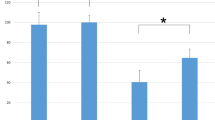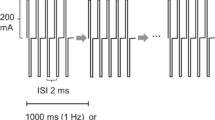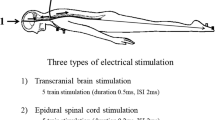Abstract
Transcranial motor evoked potentials (TcMEPs) are widely used to monitor motor function during spinal surgery. Improvements in transcranial stimulation techniques and general anesthesia have made it possible to record reliable and reproducible potentials. However, TcMEPs are much smaller in amplitude compared with compound muscle action potentials (CMAPs) evoked by maximal peripheral nerve stimulation. In this study, multi-train transcranial electrical stimulation (mt-TES) was introduced to enhance TcMEPs, and the optimal setting of mt-TES was investigated. In 30 patients undergoing surgical correction of spinal deformities (4 males and 26 females with normal motor status; age range 11–75 years), TcMEPs from the abductor hallucis (AH) and quadriceps femoris (QF) were analyzed. A multipulse (train) stimulus with an individual pulse width of 0.5 ms and an inter-pulse interval of 2 ms was delivered repeatedly (2–7 times) at different rates (2, 5, and 10 Hz). TcMEP amplitudes increased with the number of train stimuli for AH, with the strongest facilitation observed at 5 Hz. The response amplitude increased 6.1 times on average compared with single-train transcranial electrical stimulation (st-TES). This trend was also observed in the QF. No adverse events (e.g., seizures, cardiac arrhythmias, scalp burns, accidental injury resulting from patient movement) were observed in any patients. Although several facilitative techniques using central or peripheral stimuli, preceding transcranial electrical stimulation, have been recently employed to augment TcMEPs during surgery, responses are still much smaller than CMAPs. Changing from conventional st-TES to mt-TES has potential to greatly enhance TcMEP responses.




Similar content being viewed by others
References
Jellinek D, Jewkes D, Symon L. Noninvasive intraoperative monitoring of motor evoked potentials under propofol anesthesia: effect of spinal surgery on the amplitude and latency of motor evoked potentials. Neurosurgery. 1991;29:551–7.
Keller BP, Haghighi SS, Oro JJ, Eggerrs GWN. The effect of propofol anesthesia on transcortical electric evoked potentials in the rat. Neurosurgery. 1992;30:557–60.
Taylor BA, Fennelly ME, Taylor A, Farrell J. Temporal summation—the key to motor evoked potential spinal cord monitoring in humans. J Neurol Neurosurg Psychiat. 1993;56:104–6.
Jones SJ, Harrison R, Koh KF, Mendoza N, Crockard HA. Motor evoked potential monitoring during spinal surgery: response of distal limb muscle to transcranial cortical stimulation with pulse train. Electroencephalogr Clin Neurophysiol. 1996;100:375–83.
Pechstein U, Cedzich C, Nadstawek J, Schramm J. Transcranial high-frequency repetitive electrical stimulation for recording myogenic motor evoked potentials with the patient under general anesthesia. Neurosurgery. 1996;39:335–44.
Woodforth IJ, Hicks RG, Crawford MR, Stephen JP, Burke DJ. Variability of motor-evoked potentials recording during nitrous oxide anesthesia from the tibialis anterior muscle after transcranial electrical stimulation. Anesth Analg. 1996;82:744–9.
Tsutsui S, Yamada H, Hashizume H, Minamide A, Nakagawa Y, Iwasaki H, Yoshida M. Quantification of the proportion of motor neurons recruited by transcranial electrical stimulation during intraoperative motor evoked potential monitoring. J Clin Monit Comput. 2013;27:633–7.
Kothbauer K, Deletis V, Epstein FJ. Intraoperative spinal cord monitoring for intramedullary surgery: an essential adjunct. Pediatr Neurosurg. 1997;26:247–54.
Cioni B, Meglio M, Rossi GF. Intraoperative motor evoked potentials monitoring in spinal neurosurgery. Arch Ital Biol. 1999;137:115–26.
Meylaerts SA, Jacobs MJ, van Iterson V, De Haan P, Kalkman CJ. Comparison of transcranial motor evoked potentials and somatosensory evoked potentials during thoracoabdominal aortic aneurysm repair. Ann Surg. 1999;230:742–9.
Kombos T, Suess O, Ciklatekerlio O, Brock M. Monitoring of intraoperative motor evoked potentials to increase the safety of surgery in and around the motor cortex. J Neurosurg. 2001;95:608–14.
Langeloo DD, Lelivelt A, Louis JH, Slappendel R, de Kleuver M. Transcranial electrical motor-evoked potential monitoring during surgery for spinal deformity: a study of 145 patients. Spine (Phila Pa 1976). 2003;28:1043–50.
Hilibrand AS, Schwartz DM, Sethuraman V, Vaccaro AR, Albert TJ. Comparison of transcranial electric motor and somatosensory evoked potential monitoring during cervical spine surgery. J Bone Jt Surg Am. 2004;86:1248–53.
Calancie B, Molano MR. Alarm criteria for motor-evoked potentials. What’s wrong with the “presence-or-absence” approach? Spine (Phila Pa 1976). 2008;33:406–14.
Sakaki K, Kawabata S, Ukegawa D, Hirai T, Ishii S, Tomori M, Inose H, Yoshii T, Tomizawa S, Kato T, Shinomiya K, Okawa A. Warning thresholds on the basis of origin of amplitude changes in transcranial electrical motor-evoked potential monitoring for cervical compression myelopathy. Spine (Phila Pa 1976). 2012;37:E913–21.
Muramoto A, Imagama S, Ito Z, Wakao N, Ando K, Tauchi R, Hirano K, Matsui H, Matsumoto T, Matsuyama Y, Ishigro N. The cutoff amplitude of transcranial motor-evoked potentials for predicting postoperative motor deficits in thoracic spine surgery. Spine (Phila Pa 1976). 2013;38:E21–7.
Iwasaki H, Tamaki T, Yoshida M, Ando M, Yamada H, Tsutsui S, Takami M. Efficacy and limitations of current methods of intraoperative spinal cord monitoring. J Orthop Sci. 2003;8:635–42.
Tsutsui S, Tamaki T, Yamada H, Iwasaki H, Takami M. Relationships between the changes in compound muscle action potentials and selective injuries to the spinal cord and spinal nerve roots. Clin Neurophysiol. 2003;114:1431–6.
MacDonald DB, Stigsby B, Al Homoud I, Abalkhail T, Mokeem A. Utility of motor evoked potentials for intraoperative nerve root monitoring. J Clin Neurophysiol. 2012;29:118–25.
Andersson G, Ohlin A. Spatial facilitation of motor evoked responses in monitoring during spinal surgery. Clin Neurophysiol. 1999;110:720–4.
Journée HL, Polak HE, de Kleuver M, Langeloo DD, Postma AA. Improved neuromonitoring during spinal surgery using double-train transcranial electrical stimulation. Med Biol Eng Comput. 2004;42:110–3.
Kakimoto M, Kawaguchi M, Yamamoto Y, Inoue S, Horiuchi T, Nakase H, Sakaki T, Furuya H. Tetanic stimulation of the peripheral nerve before transcranial electrical stimulation can enlarge amplitudes of myogenic motor evoked potentials during general anesthesia with neuromuscular blockade. Anesthesiology. 2005;102:733–8.
Frei FJ, Ryhult SE, Duitmann E, Hasler CC, Luetschg J, Erb TO. Intraoperative monitoring of motor evoked potentials in children undergoing spinal surgery. Spine (Phila Pa 1976). 2007;32:911–7.
Hayashi H, Kawaguchi M, Yamamoto Y, Inoue S, Koizumi M, Ueda Y, Takakura Y, Furuya H. Evaluation of reliability of post-tetanic motor evoked potential monitoring during spinal surgery under general anesthesia. Spine (Phila Pa 1976). 2008;33:E994–1000.
Deletis V. Intraoperative neurophysiology and methodologies used to monitor the functional integrity of the motor system. In: Deletis V, Shils JL, editors. Neurophysiology in neurosurgery. New York: Academic Press; 2002. p. 25–51.
MacDonald DB, Al Zayed Z, Khoudeir I, Stigsby B. Monitoring scoliosis surgery with combined multiple pulse transcranial electric motor and cortical somatosensory-evoked potentials from the lower and upper extremities. Spine (Phila Pa 1976). 2003;28:194–203.
MacDonald DB, Al Zayed Z, Al SaddigiA. Four-limb muscle motor evoked potential and optimized somatosensory evoked potential monitoring with decussation assessment: results in 206 thoracolumbar spine surgeries. Eur Spine J. 2007;16(Suppl 2):171–87.
Deletis V, Sala F. Corticospinal tract monitoring with D- and I-waves from the spinal cord and muscle MEPs from limb muscles. In: Nuwer MR, editor. Intraoperative monitoring of neural function. Handbook of clinical neurophysiology, vol. 8. Amsterdam: Elsevier; 2008. p. 235–51.
MacDonald DB, Skinner S, Shils J, Yingling C. Intraoperative motor evoked potential monitoring—a position statement by the American Society of Neurophysiological Monitoring. Clin Neurophysiol. 2013;124:2291–316.
Matsuda H, Shimazu A. Intraoperative spinal cord monitoring using electric responses to stimulation of caudal spinal cord or motor cortex. In: Desmedt JE, editor. Neuromonitoring in surgery. Amsterdam: Elsevier; 1989. p. 175–90.
Journée HL, Polak HE, de Kleuver M. Conditioning stimulation techniques for enhancement of transcranially elicited evoked motor responses. Neurophysiol Clin. 2007;37:423–30.
Hemmer LB, Zeeni C, Bebawy JF, Bendok BR, Cotton MA, Shah NB, Gupta DK, Koht A. The incidence of unacceptable movement with motor evoked potentials during craniotomy for aneurysm clipping. World Neurosurg. 2012;. doi:10.1016/j.wneu.2012.05.034.
Penfield W, Boldrey E. Somatic motor and sensory representation in the cerebral cortex of man as studied by electrical stimulation. Brain. 1937;60:339–443.
Ethical standards
The experiments comply with the current laws of Japan.
Conflict of interest
None.
Author information
Authors and Affiliations
Corresponding author
Rights and permissions
About this article
Cite this article
Tsutsui, S., Iwasaki, H., Yamada, H. et al. Augmentation of motor evoked potentials using multi-train transcranial electrical stimulation in intraoperative neurophysiologic monitoring during spinal surgery. J Clin Monit Comput 29, 35–39 (2015). https://doi.org/10.1007/s10877-014-9565-7
Received:
Accepted:
Published:
Issue Date:
DOI: https://doi.org/10.1007/s10877-014-9565-7




